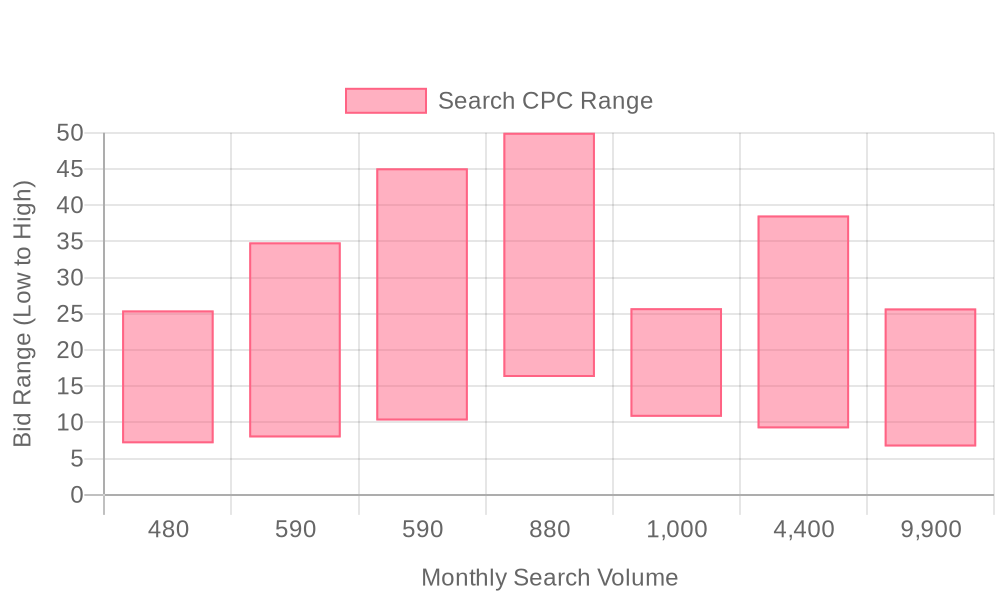
Supercharge your lead generation with a FREE Google Ads audit - no strings attached! See how you can generate more and higher quality leads
Get My Free Google Ads AuditFree consultation

No commitment
Supercharge your lead generation with a FREE LinkedIn Ads audit - no strings attached! See how you can generate more and higher quality leads
Get My Free Google Ads AuditFree consultation

No commitment
Supercharge your lead generation with a FREE Meta Ads audit - no strings attached! See how you can generate more and higher quality leads
Get My Free Google Ads AuditGet My Free LinkedIn Ads AuditGet My Free Meta Ads AuditFree consultation

No commitment
Supercharge your lead generation with a FREE Google Ads audit - no strings attached! See how you can generate more and higher quality leads
Get My Free Google Ads AuditFree consultation

No commitment
In today's complex marketing landscape, effective B2B marketing for medical liability insurance requires a strategic mix of both online and offline channels working in concert. Online channels like social media build digital brand awareness, email marketing nurtures ongoing relationships, and SEO drives organic visibility. Meanwhile, offline channels such as industry seminars generate face-to-face connections, direct mail creates tangible touchpoints, and industry publications establish thought leadership. Within this integrated ecosystem, Google Ads plays a critical middle-funnel role by capturing high-intent prospects at the exact moment they're searching for solutions—effectively bridging the gap between broader awareness efforts and your sales process. This strategic integration becomes vital as incomplete or outdated account data can hamper personalization and cause missed segmentation opportunities. For medical liability insurance providers, Google Ads represents a powerful opportunity to bridge online and offline marketing efforts: Intercept decision-makers at their precise moment of need, whether they're following up after an industry seminar or responding to a direct mail piece; Target with precision based on technical specifications and specialized terminology unique to your industry; Monitor high-value prospects with account-level analytics, ensuring priorities align with their engagement level; Measure ROI completely by tracking from click to quote to closed deal, connecting digital touchpoints with offline sales; Complement other channels through remarketing to publication readers, seminar attendees, and digital audiences alike.

Medical liability insurance providers operate within a demanding market where lead quality and conversion speed directly influence revenue. Modern B2B marketers competing in this space require actionable frameworks that blend precision targeting, real-time audience insights, and seamless data orchestration across channels. Data-driven campaign execution is essential for sustainable pipeline growth.
This guide delivers a comprehensive, stepwise playbook for generating and capturing high-value leads through Google Ads for Medical Liability Insurance. Each section is designed for B2B service providers and local operators aiming to maximize campaign efficiency, unify lead and intent data, and drive revenue outcomes without manual bottlenecks. The framework accounts for both marketing and sales needs, ensuring every qualified inquiry is surfaced to your team at the optimal moment for engagement, and every touchpoint is measured for true ROI.
Medical liability insurance advertising faces unique challenges: strict compliance standards, complex buyer journeys, and premium cost per lead. Despite these obstacles, Google Ads remains one of the highest-performing acquisition channels for insurance agencies and brokers targeting medical professionals. With robust keyword intent data, granular audience controls, and lead capture flexibility, Google Ads allows marketers to reach physicians, clinics, and healthcare executives at the peak of their research activity.
The platform’s ability to match search queries with specialized medical malpractice offerings drives unparalleled intent alignment. By layering in real-time behavior tracking and dynamic audience management, advertisers can focus budget and messaging only on those accounts showing actionable purchase signals. This strategic approach shortens sales cycles and amplifies conversion rates, particularly when paired with up-to-date CRM data and advanced attribution models.

For campaign setup tips tailored to insurance agents, see this Google Ads best practices guide.

A successful paid search strategy for medical liability insurance operates best as part of a unified, multi-channel marketing ecosystem. Integrating Google Ads with email, content syndication, and outbound sales efforts ensures that every qualified lead is nurtured across touchpoints. Real-time CRM synchronization eliminates delays, so no hot opportunity is missed, and enriched audience data supports personalized follow-up at scale.
Modern marketers can leverage dynamic audience creation, intent data, and seamless cross-channel attribution to optimize spend and prioritize outreach. This data-driven approach maximizes ROI, reduces wasted budget, and creates a closed-loop system where every marketing action is measurable, attributable, and actionable. Ready to streamline your pipeline? Get started for free with Sona.
Medical liability insurance providers operate in a highly specialized sector where trust, expertise, and speed drive both client acquisition and retention. Google Ads empowers these organizations to reach healthcare professionals and decision-makers the moment they search for risk management solutions tailored to their practice or facility.
Digital advertising fills critical gaps left by traditional outreach, connecting insurers with practitioners during regulatory changes or litigation spikes. Google Ads enables precise targeting of high-margin services, capturing prospects who are actively seeking coverage but have not yet entered your sales funnel. For additional in-depth tactics, explore our collection of actionable playbooks.
Modern revenue teams benefit from the regional flexibility Google Ads provides, expanding into emerging markets where offline relationships are still forming. Advanced analytics now bridge the gap between online and offline engagements, allowing for closed-loop measurement from initial click through to signed contracts. With solutions that unify data from multiple sources, marketers gain a comprehensive view of which campaigns influence both digital and offline conversions, ensuring budget is allocated to the channels with the highest impact.
Integrating visitor identification and real-time intent data allows marketing teams to move beyond anonymous website traffic, pinpointing the actual companies and professionals engaging with medical liability insurance content. Audiences can be dynamically refined as leads progress through the pipeline, while enriched data syncs seamlessly into CRM and ad platforms. This enables continuous optimization, accurate ROI measurement, and highly personalized outreach that accelerates deal cycles and maximizes marketing investment. Get started for free with Sona.


Medical liability insurance marketers face intense competition and a limited universe of qualified prospects. Achieving sustainable growth requires uncovering fresh channels and targeting methods that move beyond basic search campaigns and generic content. Revenue teams that adopt a data-driven, verticalized approach can unlock new segments and improve lead quality while reducing wasted spend.
Expanding reach begins with a deep dive into specialty service keywords that complement broader campaigns. Targeting niche phrases such as "malpractice insurance for anesthesiologists" or "medical liability coverage for outpatient clinics" allows teams to attract high-intent prospects often overlooked by competitors. For a strategic edge, reference this list of top Google Ads keywords for insurance companies to supplement your foundational targeting and build a robust funnel that captures both volume and value.
Competitor gap analysis is essential for identifying underserved audience segments and opportunities. Using auction insights, advertisers can reveal which medical specialties or geographic regions receive limited coverage from established players. This intelligence supports budget reallocation toward less saturated areas, increasing impression share among high-potential buyers. When combined with visitor identification and real-time intent tracking, marketers can dynamically shift budgets to focus on accounts displaying strong purchase signals.
Industry-specific placements further augment reach outside the traditional search ecosystem. Sponsoring listings or banner placements in medical association directories, specialty trade forums, and continuing education sites connects insurers with decision-makers during research and renewal cycles. Medical malpractice insurance coverage is a top priority for many healthcare professionals, and these placements ensure messaging is tailored and contextually relevant to each audience segment.
Content retargeting plays a crucial role in overcoming the pitfalls of one-size-fits-all campaigns. By deploying assets such as whitepapers, checklists, and instructional videos, marketers deliver timely, personalized messaging that nurtures prospects over longer sales cycles. With dynamic audience updates and CRM integration, it becomes possible to retarget visitors with assets specific to their specialty, risk profile, or stage in the buying journey. This personalization increases engagement rates and shortens the path from initial interest to conversion, while capturing valuable attribution data that informs future optimization.
Growth in medical liability insurance marketing hinges on precision—reaching the right specialty, at the right moment, with the right message. Teams that unify their intent, audience, and conversion data can confidently identify and pursue the highest-yield opportunities in a market where compliance and personalization are paramount. If you’re ready to accelerate your pipeline and elevate your marketing precision, get started for free with Sona.

Modern revenue teams in the medical liability insurance industry achieve stronger results when they align their audience segmentation to every stage of the customer journey. Segmentation grounded in precise audience intelligence and behavioral data allows marketers to move beyond generic targeting, unlocking higher engagement and more qualified leads.
For medical liability insurance, clear distinctions exist between key audience groups. Hospitals, large medical groups, and individual practitioners each present unique risk profiles, regulatory obligations, and coverage needs. By defining these segments—such as separating campaigns for hospital administrators evaluating group coverage versus solo practitioners seeking personal protection—marketers can tailor messaging, creative assets, and value propositions to match the real-world priorities of each buyer type. Overlaying additional intent signals, such as recent regulatory changes or specialty-specific compliance pressures, enables even tighter alignment between ad delivery and audience readiness.
Creating dedicated ad groups for each segment provides granular control over budgets, keywords, and creative. For example, a campaign targeting high-volume hospital prospects can prioritize keywords aligned with “enterprise malpractice coverage” and highlight multi-provider risk management features. In contrast, ad groups for independent practitioners can focus on affordability, fast underwriting, and niche specialties. This separation ensures that every dollar spent is directed at the prospects most likely to convert, with messaging that speaks directly to their business reality. As prospects interact with ads and landing pages, dynamic audience lists update in real time, ensuring that high-intent leads remain prioritized as they move through the funnel.
Conversion path validation is essential for measuring the true effectiveness of segmented campaigns. With robust integration between ad platforms and CRM systems, marketers can track not just form fills or quote requests, but also offline conversions such as policy signings or renewals. Sophisticated revenue attribution closes the loop by connecting marketing activity to actual revenue, providing a detailed, actionable ROI picture. For insights on maintaining compliance with advertising regulations, see Google Ads healthcare policy compliance. This continuous feedback cycle ensures that every segment remains engaged with relevant, timely campaigns, and that marketing dollars consistently support business growth.
Ready to see how segmentation and real-time insights can power your growth? Get started for free with Sona.

| Industry | Keyword | Monthly Search Volume | Competition Level | Low Bid | High Bid |
| Medical Liability Insurance | medical liability insurance | 480 | MEDIUM | 7.13 | 25.47 |
| Medical Liability Insurance | malpractice insurance for doctors | 590 | MEDIUM | 7.94 | 34.87 |
| Medical Liability Insurance | physician assistant malpractice insurance | 590 | MEDIUM | 10.28 | 45.09 |
| Medical Liability Insurance | best malpractice insurance for nurse practitioners | 880 | HIGH | 16.28 | 50 |
| Medical Liability Insurance | best malpractice insurance for nurses | 1000 | HIGH | 10.78 | 25.78 |
| Medical Liability Insurance | medical malpractice insurance | 4400 | LOW | 9.19 | 38.58 |
| Medical Liability Insurance | malpractice insurance | 9900 | MEDIUM | 6.69 | 25.74 |
Medical liability insurance buyers are highly informed decision-makers who turn to search engines when actively evaluating coverage options. Capturing these moments of intent requires a precise keyword strategy that aligns ad spend with the terms healthcare professionals use while researching policies. By targeting high-intent searches, marketers intercept leads at the critical stage when prospects are prepared to compare quotes, review providers, and take action. For additional insights on structuring insurance campaigns, see Google Ads best practices for insurance agents.
A successful Google Ads for Medical Liability Insurance campaign relies on mapping the buyer journey to tightly grouped keyword segments. Core head terms such as “medical malpractice insurance,” “medical liability insurance quotes,” and “doctor malpractice coverage” anchor the account structure, driving visibility for foundational queries. Supporting these, long-tail variations like “affordable medical liability insurance for surgeons,” “malpractice insurance for OB/GYNs in California,” and “best medical liability carrier for small practices” help attract specialty-specific prospects and reduce wasted clicks. Incorporating negative keywords, such as “free legal advice” or “malpractice attorney,” filters out irrelevant traffic and protects budget efficiency. To deepen your strategy, explore the top-performing Google Ads keywords for insurance companies.
Dynamic keyword strategy is enhanced when marketers leverage real-time audience insights and behavioral data. Unified tracking surfaces the actual organizations and professional segments engaging with high-value keyword sets, allowing for continuous optimization. As prospects move from awareness to consideration, enriched audience data updates automatically, ensuring ads stay relevant to each step of the buying process. Integrating CRM and web interaction data further allows marketers to sync lists of engaged contacts or target accounts directly into Google Ads, aligning spend with the highest-propensity segments and accelerating pipeline impact.
Sample target terms for medical liability insurance campaigns include:
This robust keyword foundation ensures campaigns are discoverable by healthcare professionals when they are most likely to engage with insurance providers. Unified data and advanced audience management enable ongoing refinement, allowing revenue teams to focus on the search terms and segments that deliver measurable business outcomes. To experience how unified audience data can transform your marketing, get started for free with Sona.
Building a robust keyword list is the foundation for high-performing Google Ads for medical liability insurance. Start by clustering keywords around core service types such as “medical malpractice insurance,” “doctor liability coverage,” and “hospital professional indemnity.” Enhance specificity and local relevance by adding geographic modifiers (e.g., “malpractice insurance California,” “medical liability coverage Texas”), which tailors campaigns to state regulatory nuances and competitive conditions. Integrate long-tail and question-based queries—examples include “affordable medical malpractice insurance for plastic surgeons” or “how does medical liability insurance work for clinics”—to attract leads closer to conversion and reduce wasted budget on broad, untargeted terms. Applying negative keyword filters is essential to block irrelevant searches, such as those targeting “legal defense advice” instead of insurance products. For a detailed list of high-performing keyword ideas, review top Google Ads keywords for insurance companies.
Aligning keywords with your content marketing taxonomy boosts both paid and organic performance. Syncing insights from CRM and web engagement data allows marketers to pinpoint which medical specialties and regions show the highest intent, revealing hidden opportunities. Connecting these keyword clusters to a unified data platform ensures that search terms and buyer signals from other channels inform keyword prioritization, so budget is focused on segments with real potential to convert. For more actionable frameworks on campaign execution, explore our marketing playbooks.
Effective ad copy for medical liability insurance must address the industry’s unique pain points—rising litigation risk, complex regulatory requirements, and the need for trusted partners. Craft headlines that highlight tangible outcomes such as “Protect Your Practice Against Lawsuits” or “Comprehensive Malpractice Coverage for Surgeons.” Use descriptions to reinforce trust markers like “A+ rated by AM Best” and promote urgency through incentives such as “Lock in 2024 Rates” or “Free Risk Assessment with Quote.” Ad extensions, including sitelinks to specialty coverage pages and callouts featuring “24/7 claims support,” increase ad visibility and drive engagement. For in-depth tips, check out this guide on crafting insurance ads headlines, copywriting, and visuals.
Consistency across touchpoints is critical. Aligning Google Ads messaging with your ongoing social and email campaigns ensures prospects receive a unified value proposition at every stage. Leveraging real-time audience insights, marketers can dynamically update ad copy to reflect trending industry concerns or legislative changes, ensuring that campaigns remain relevant and persuasive as audience needs evolve.
Landing pages for medical liability insurance must deliver a seamless, 1:1 experience that matches each ad’s promise. Each page should be segmented by medical specialty or practice type, allowing physicians, surgeons, and facility managers to find tailored information and coverage options. Incorporate ROI calculators so prospects can instantly estimate potential savings, and use trust badges—such as “HIPAA compliant” or “State Licensed”—to build confidence. Calls to action need to be clear, visible, and optimized for mobile devices, as many providers research insurance options on the go.
Connecting landing page forms directly to your CRM and automation platforms accelerates lead capture and response. When a visitor requests a quote, enriched profile data flows instantly into your pipeline, triggering appropriate follow-ups and nurturing sequences. This unified workflow eliminates manual entry errors, shortens sales cycles, and enables rapid segmentation for remarketing or cross-sell campaigns. For more on maximizing landing page performance, visit our blog on demand generation strategies.
Ongoing optimization is essential for sustained success in medical liability insurance advertising. Tracking conversions accurately—both online quote requests and offline policy sales—provides the feedback loop necessary for informed decision-making. Employ smart bidding strategies that automatically adjust bids based on predicted conversion likelihood, and continuously test ad elements (headlines, descriptions, extensions) to refine performance. Importing offline conversions, such as closed policies tracked in your CRM, closes the attribution gap and ensures your ROI calculations reflect the true value of each campaign. For guidance on integrating offline ad policies and compliance, review this comparison of evolving health-related ad policies on Google Ads and Microsoft Ads.
Insights from Google Ads should inform content creation and funnel strategies across channels. By unifying conversion, audience, and engagement data, teams can identify which campaigns drive the highest-value leads and adjust creative, targeting, and budget allocation accordingly. As leads move through the funnel, dynamic audience segments automatically update, supporting continuous engagement and maximizing the impact of retargeting and nurture initiatives. This integrated approach not only resolves the challenge of incomplete ROI measurement but also empowers revenue teams to scale what works and eliminate wasted spend.
Expanding your presence in the medical liability insurance market requires a strategic blend of targeted advertising, educational engagement, and data-driven personalization. Success hinges on your ability to not only reach high-intent healthcare professionals but also to continuously adapt campaigns to shifting regional, regulatory, and industry trends. For a deeper dive into the importance of identifying high-value website visitors, explore how Sona Identification can help reveal which companies and people are engaging with your site while maintaining privacy compliance.
Adopting these tactics gives medical liability insurance marketers a measurable edge, enabling them to unify data across channels, engage key healthcare audiences at every touchpoint, and accelerate both pipeline velocity and brand trust in a highly regulated market. If you’re ready to streamline your approach, get started for free with Sona and see how unified data and automation can drive results.
In conclusion, mastering Google Ads for promoting medical liability insurance requires a strategic approach that aligns with industry-specific needs and compliance standards. By understanding key targeting techniques and adhering to Google’s advertising policies, you can effectively reach potential clients and enhance your service visibility.
Throughout this article, we've delved into the intricacies of crafting compelling ads, selecting the right keywords, and optimizing your campaigns for maximum impact. These strategies empower you to navigate the complexities of the insurance landscape and connect with your target audience more efficiently.
Embrace the opportunity to transform your approach to digital marketing by implementing these insights. With the right tools and strategies, you can significantly improve your outreach efforts and ensure your services stand out in a competitive market.
To take your advertising efforts to the next level, start for free to experience our platform and its capabilities today.
Medical liability insurance advertising on Google Ads requires strict compliance with Google's healthcare policy, ensuring that all promotional content meets regulatory standards and accurately represents the services offered.
A successful Google Ads campaign for medical liability insurance involves using precision targeting, real-time audience insights, and integrating both online and offline data to capture high-intent leads and measure true ROI.
Best practices include using precise audience segmentation, keyword strategy aligned with buyer intent, and leveraging remarketing campaigns to engage with healthcare professionals who have shown interest in coverage options.
To advertise health insurance on Google Ads, you need to comply with Google's healthcare policy, ensuring that your ads adhere to legal and ethical standards and accurately represent the health insurance services you offer.
Google Ads policy affects advertising for medical liability insurance by enforcing compliance with healthcare advertising standards, which ensures that ads are accurate, truthful, and meet regulatory requirements.
Join results-focused teams combining Sona Platform automation with advanced Google Ads strategies to scale lead generation

Connect your existing CRM

Free Account Enrichment

No setup fees
No commitment required

Free consultation

Get a custom Google Ads roadmap for your business
Join results-focused teams combining Sona Platform automation with advanced Meta Ads strategies to scale lead generation

Connect your existing CRM

Free Account Enrichment

No setup fees
No commitment required

Free consultation

Get a custom Google Ads roadmap for your business
Join results-focused teams combining Sona Platform automation with advanced LinkedIn Ads strategies to scale lead generation

Connect your existing CRM

Free Account Enrichment

No setup fees
No commitment required

Free consultation

Get a custom Google Ads roadmap for your business
Join results-focused teams using Sona Platform automation to activate unified sales and marketing data, maximize ROI on marketing investments, and drive measurable growth

Connect your existing CRM

Free Account Enrichment

No setup fees
No commitment required

Free consultation

Get a custom Google Ads roadmap for your business
Over 500+ auto detailing businesses trust our platform to grow their revenue
Join results-focused teams using Sona Platform automation to activate unified sales and marketing data, maximize ROI on marketing investments, and drive measurable growth

Connect your existing CRM

Free Account Enrichment

No setup fees
No commitment required

Free consultation

Get a custom Google Ads roadmap for your business
Over 500+ auto detailing businesses trust our platform to grow their revenue
Join results-focused teams using Sona Platform automation to activate unified sales and marketing data, maximize ROI on marketing investments, and drive measurable growth

Connect your existing CRM

Free Account Enrichment

No setup fees
No commitment required

Free consultation

Get a custom Google Ads roadmap for your business
Over 500+ auto detailing businesses trust our platform to grow their revenue
Our team of experts can implement your Google Ads campaigns, then show you how Sona helps you manage exceptional campaign performance and sales.
Schedule your FREE 15-minute strategy sessionOur team of experts can implement your Meta Ads campaigns, then show you how Sona helps you manage exceptional campaign performance and sales.
Schedule your FREE 15-minute strategy sessionOur team of experts can implement your LinkedIn Ads campaigns, then show you how Sona helps you manage exceptional campaign performance and sales.
Schedule your FREE 15-minute strategy sessionOur team of experts can help improve your demand generation strategy, and can show you how advanced attribution and data activation can help you realize more opportunities and improve sales performance.
Schedule your FREE 30-minute strategy sessionOur team of experts can help improve your demand generation strategy, and can show you how advanced attribution and data activation can help you realize more opportunities and improve sales performance.
Schedule your FREE 30-minute strategy sessionOur team of experts can help improve your demand generation strategy, and can show you how advanced attribution and data activation can help you realize more opportunities and improve sales performance.
Schedule your FREE 30-minute strategy sessionOur team of experts can help improve your demand generation strategy, and can show you how advanced attribution and data activation can help you realize more opportunities and improve sales performance.
Schedule your FREE 30-minute strategy session





Launch campaigns that generate qualified leads in 30 days or less.
